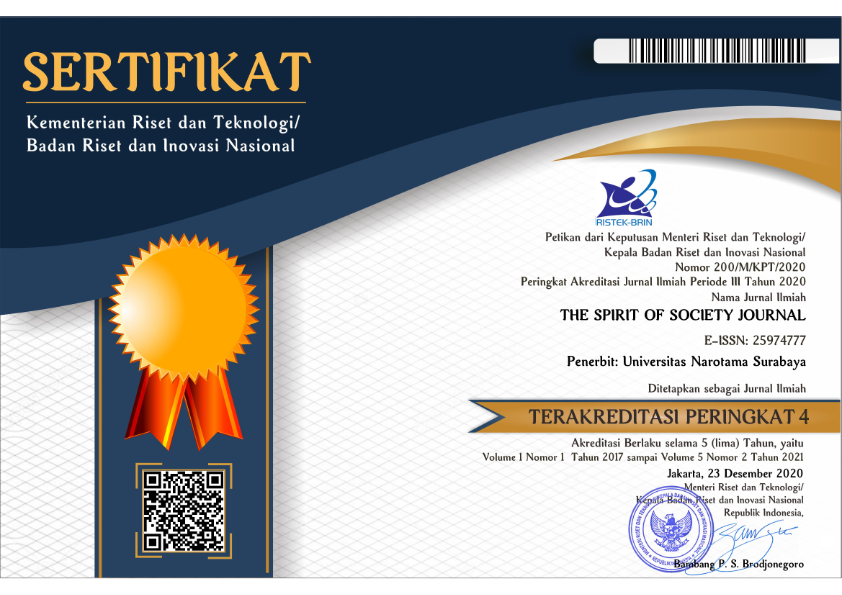Revitalization Of Agropolitan-Based Subdistrict Development In Kapuas Regency
Abstract
This study examines and analyzes the revitalization that is managed in the study of the alignment of Regional Government and Sectoral SKPD policies, and analyzes the Revitalization of Agropolitan Areas from the point of view of the Gap between Traditional Area Patterns and Agropolitan Patterns in Kapuas Regency. This study uses a qualitative approach that emphasizes facts and field phenomena to reveal issues related to the implementation of real estate policies. The results of the research design a policy implementation model theory from Edward III, and can be implemented in the KAFE (Kapuas Agropolitan Food Estate) project, namely the revitalization of agropolitan policies in developing superior commodity-based agropolitan areas in developing regional economies in superior local rice agropolitan areas, Dadahub District, Kapuas Regency is a policy on agropolity land of 20,000 ha in stages of 10,000 Ha and continue until 2022; and development of the economic development of agropolitan districts, which is the goal of realizing modern agricultural areas as drivers of the rural economy that are able to prosper the community. Formulation of the pattern and structure of the agropolitan area according to its function because it accelerates economic growth as a center of growth so that it becomes a center of superior local rice. Four characteristics of the pattern and structure of agropolitan areas as centers of growth, especially the existence of internal relations of various types of activities, multiplier elements, the presence of geographical concentration, and the nature of encouraging the growth of the area behind it.
Downloads
References
Allkire, S. & Foster, J. (2011). Counting and multidimensional poverty measures. Journal ofPublic Economics, 95 (7 8), 476 -487.
Asan A. G. H. (2008). Pembangunan wilayah dan alam sekitar: Cabaran dalam merealisasikan Rancangan Malaysia Kesembilan. Sintok: Penerbit UUM.
Bayu. 2021, Food Estate: Konsep Pengembangan Pangan" selengkapnya https://news.detik.com/opini/d-1252310/food-estate-konseppengembangan-pangan. Chichester: John Wiley. Economic Planning Unit (2015). Elevent h Malaysia plan, 2016-2020: Anchoring growth on people . Putrajaya: Prime Minister’s Department.
Bhisna, N. B. (1995). Promoting small towns for rural development: A view from Nepal, Asia Pacificulation Journal, 10 (2), 27- 50.
Buang, A., Habibah, A., Hamzah, J., & Ratnawati, Y. S. (2011). The agropolitan way ofreempowering the rural poor. World Applied Sciences Journal, 13, 16.
Douglas, M. (1981). Thailand: Territorial dissolution and alternative regional development for the central plains. In W. Stohr & D.R.F. Taylors (Eds), Planningrom above or below?(pp. 183-208).
Friedmann, J., & Douglass, M. (1978). Agropolitan development: towards a new strategy for regional planning in Asia. In F. Lo & K. Salih (Eds), Growth pole strategy for regional development policy (pp. 163-192). Oxford: Pergamon Press.
Friedmann, J., & Weaver, C. (1979). Territory and function London: Edward Arnold. Haris, Abdul. 2005. Pengaruh Penatagunaan Tanah Terhadap Keberhasilan Pembangunan Infrastrukturdan Ekonomi. Hal 1.
Hardoy, J. E., & Satterthwaite, D. (1986). Shelter, infrastructure and services in ThirdWorld cities.Habitat international 10 (3), 245 – 284
Hayroll, A. M. S., Ahmad, F. A. N., Khairuddin, I., Jegak, U., & Jeffrey L. D. (2010). Agriculture project as an economic development tool to boost socio - economic level f poor community: The case of agropolitan project in Malaysia. African Journal of usiness Management, 4 (11), 2354 -2361.
Jaya, Askar. (2004). Konsep Pembangunan Berkelanjutan (Sustainable Development). PengantarFalsafah Sains (PPS-702). Hal 1.
Mohamadm Syamsul; Sa’id, Endang Gumbira; Bantacut, Tajuddin; Munandar, Aris (2011). "Model Pemilihan Kelembagaan Agropolitan Berbasis Agroindustri Dengan Analytical Network Process Agroindustry Based Agropolitan Institutional Design With Analytical Network ProcessVol 19, No 3 .
Copyright (c) 2023 THE SPIRIT OF SOCIETY JOURNAL : International Journal of Society Development and Engagement

This work is licensed under a Creative Commons Attribution-ShareAlike 4.0 International License.










